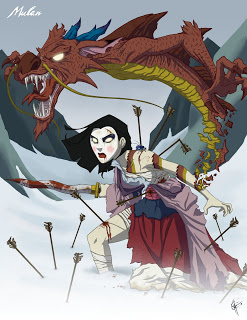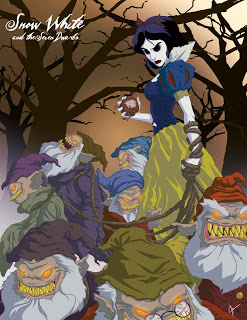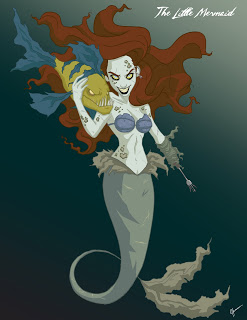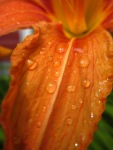Banksy hires an older gentleman to sell genuine Banksy art for the small price of $60. Without the label, the art went unrecognized and only a few pieces sold. Imagine those people if they ever realize what their purchases are worth.
Local Artist Feature: Kay Cochran
September 30, 2013
I tend to post a lot of things on famous artists or contemporary artists on a global scale, but I am also fortunate to know many wonderful creative people locally. I sent out some inquiries in hopes of featuring a few such people. Today’s feature: Kay Cochran.

“Born to Be” by Miss Kay Cochran
How would you describe your work?
My work falls under the broad spectrum of illustration, but it’s really, well–primarily categorized as pop-surrealist with a neo-traditional twist. I take a lot of inspiration from the whimsical and strange. I do like to dabble in the macabre occasionally (there’s just something about darkness that makes the light brighter), but for the most part I focus on peppy characters.
How long have you been doing your art?
I didn’t really consider art a serious life-long pursuit. Every single counselor I’ve had has told me to ‘get a real job’. But, one does not simply ignore one’s passion…with the encouragement of my parents, I began to take my art seriously. Heck, my entire first year of college–I was so intimidated; there were so many people who had worked so hard, and their skill level was absolutely through the roof–right off the get-go. But me–ha…I was just scratching the surface of the art world–the industry was 100% new to me. So I’ve actually only been comfortable enough in my own artistic skin–for about a year and a half. So that is the measurement I prefer to go by.
What materials/media do you gravitate to?
Pencils! Pens! Markers! Found papers! I do my sketches and then scan them into the computer–then I get to work on creating artwork people would be proud to own. I love doing originals on paper, but I also like to do digital manipulation, just to tweak and play! That’s just me; but really, I encourage students of art to not let themselves be held back by: ‘well I don’t have a fancy computer like yours’ or ‘I only have #2 pencils’ –ha, details, details. People have been making incredible art with #2 pencils. So make your art–use those number two pencils. Make that your statement.

“The Wisdom of the World – The Socrates” by Miss Kay Cochran
What inspired you to begin your art?
My brain. Ha. Usually People would talk about artists that they like here, huh? But my brain has been throwing ideas at me since I opened my wee-little-babe-like eyes. I have sketchbooks full of potential ideas, and I have lists in my phone for when I have an art idea on the go. I think the most stressful place to get ideas is when driving…there’s no way to record your thoughts AND be an attentive driver!
What artists do you look to for inspiration?
My top four favorites right now are Bob Million, Mark Ryden, Sara Fabel & Kurtis Rykovich. Always. All the time. I follow them on Instagram and can never get enough of their wacky realities. I’ve had conversations with a couple of them, and they’re actually incredible individuals.
What are your favorite things or themes to depict?
I love the philosophical. I feel like art has no place if it doesn’t interact with the viewer on some intrinsic level. Sometimes art doesn’t make sense–and that is the response that artists’ are looking for. But I feel, more often than not–that art should make people feel & make people think. But not too awfully hard. Completely off-the-wall meanings have no depth to me.

“Eye of Mine” by Miss Kay Cochran
Favorite quotes?
OH I HAVE A TON. CAN I GIVE YOU A LIST?Oh lemme’ please give you a list of my latest and greatest finds:
“By three methods we may learn wisdom: First, by reflection, which is noblest: Second, by imitation, which is easiest; and third by experience, which is bitterest.” -Confucius
“I don’t like people who have never fallen or stumbled. Their virtue is lifeless and it isn’t of much value. Life hasn’t revealed its beauty to them.” -Boris Pasternak
“Imagination does not become great until human beings. given the courage and the strength, use it to create.” -Maria Montessori
“Remember when you started and you didn’t know, at all what you were doing, but how you loved it so.” -Dallas Clayton
“These violent delights have violent ends / And in their triumph die, like fire and powder / Which, as they kiss, consume.” -William Shakespeare (Romeo and Juliet, Act II, Scene VI
“It’s a dangerous mission. You could die out there. You could go on forever.” -Tess Gallagher
“May you live every day of your life.” -Jonathan Swift “You see things; you say, ‘Why?’ But I dream things that never were; and I say ‘Why not?’ -George Bernard Shaw
Top five favorite creations by yourself?
I don’t do that to myself. Ranking work makes me cranky. Ya’ see–I think that everything I make has flaws. Trying to justify which work goes over which just pits those flaws against each other. So I just–like–enjoy them all.
If you had a dream project, what would it be/who with/what with?
Oh my gosh. I would do some type of painting collaboration with Bob Million. That man is crazy amazing. I think I would do a bust series with him. He could teach me how to do awesome-sauce oil painting. Share with me those deep, dark artistic secrets.
What’s your favorite color?
I like them all. But I’m attracted to Cornflower Blue, Honeydew & Coral.

“Your Luscious Lies” by Miss Kay Cochran
Pirates or ninjas?
ARRRRRG…ga. Because there has to be a ‘captain’ in there somewhere.
If you had $500 to buy art supplies, what you you get?
PHOTOSHOP ILLUSTRATOR. Spend it all in one place. Yes indeed.
What’s been your favorite artistic failure or learning experience?
Oh gosh–do artists have favorite failures? Well, my mural at the high school I graduated from. That’s a pretty big, monumental failure–I think about it an awful lot. I wish I could just sneak back in and do it all over again. It just makes me cringe. Thinking about it. Ughhaaa.
If you could work with any artist, past or present, who would you choose?
Hieronymus Bosch. That man was ridiculously crazy and ridiculously talented. For the opportunity to work with him? Oh jeesh–I would give everything up to; but not excluding–my great aunt Sue.
What about if you just wanted to meet and talk to an artist from past or present?
Still Bosch. The man was a menace. For him–I could learn to like menaces.
[Editor’s Note: I was originally inspired to feature Kay after seeing this promotional video she created for Boise State University’s illustration program.]
Websites, blogs, tumblr, stores etc?
- Facebook: https://www.facebook.com/pages/Miss-Kay-Illustration/218221438192462?ref=stream&hc_location=stream
- Instagram: theMisKay
- Store: http://www.redbubble.com/people/charadedkay?ref=artist_title_name
So that’s it folks! Go check out her stuff!
A beautiful evolution throughout art history.
CBS Presents a profile of artist Wayne Thiebaud.
How to Recognize the Work of Artists
Here’s a funny link for those interested in art history. Consider it a politically incorrect Spark Notes.
Neil Gaiman’s words of advice: Make Good Art
I remember watching Bob Ross paint when I was a kid. I was too young to get much from it, but I was starved for art and this helped give me a dose of it.
This song is mostly for kicks and giggles, but it does have a good message – If you believe in yourself, and practice, you can make art. This is something I’m always trying to communicate to my friends and students, who all too often discount themselves with the phrase “I can’t even draw a stick figure.” You have to believe in yourself first, to give it a chance. Thanks for believing in us, Bob Ross. RIP.
On a side note, school has started again and I’m student teaching as well as pursuing my Master’s degree, so the frequency of posts on this blog is probably going to go down for a while. I hope you’ll still stop by now and then.
Glitch Art
August 13, 2013
[youtube http://www.youtube.com/watch?v=r940y3N1Yns%5D
This is both fascinating and creepy at the same time. It was uploaded by YouTube user pixeloo, who asks that viewers visit his blog.
Adrift from Simon Christen on Vimeo.
“Adrift” is a love letter to the fog of the San Francisco Bay Area. I chased it for over two years to capture the magical interaction between the soft mist, the ridges of the California coast and the iconic Golden Gate Bridge. This is where “Adrift” was born.
Color Theory Game
July 22, 2013
Color – Method of Action
Method of Action is an online course on design for analytical minds.
Here’s a fun color theory game online. It’s an interactive game that tests your ability to match color based on hue, saturation, and colors schemes of complementary, analogous, triadic and tetradic. You move your mouse over a color wheel to match the prompted color or scheme, all the while being timed. At the end of the game you get a numerical score. I did a quick video tutorial to show you how it works.
The game can be found here.
Stolen Art, Crisped?
July 19, 2013
Breaking news in the art world… and it makes me sick.
The two sources I’ve read about this on:
Apparently a slew of famous paintings were stolen from the Kunsthal Netherland museum…
The stolen paintings were: Pablo Picasso’s 1971 “Harlequin Head”; Claude Monet’s 1901 “Waterloo Bridge, London” and “Charing Cross Bridge, London”; Henri Matisse’s 1919 “Reading Girl in White and Yellow”; Paul Gauguin’s 1898 “Girl in Front of Open Window”; Meyer de Haan’s “Self-Portrait,” around 1890; and Lucian Freud’s 2002 work “Woman with Eyes Closed.”
…and now forensics scientists are analyzing ashes from a wood stove belonging to the main suspect’s mother. They think she burned them. If you’re like me, and the possibility make your stomach drop and heave in the most unpleasant of ways, you may need a moment or two to recouperate. I’ll wait.
Feeling any better yet? Here’s the rest of the story. The Huffington Post says Olga Dogaru, the mother of the cheif suspect, “told investigators she was scared for her son after he was arrested in January and buried the art in an abandoned house and then in a cemetery in the village of Caracliu. She said she later dug them up and burned them in February after police began searching the village for the stolen works.”
The New York Times reports, “To Olga Dogaru, a lifelong resident of the tiny Romanian village of Carcaliu, the strangely beautiful artworks her son had brought home in a suitcase four months earlier had become a curse…But if the paintings and drawings no longer existed, Radu Dogaru, her son, could be free from prosecution, she reasoned. So Mrs. Dogaru told the police that on a freezing night in February, she placed all seven works — which included Monet’s 1901 “Waterloo Bridge, London”; Gauguin’s 1898 “Girl in Front of Open Window”; and Picasso’s 1971 “Harlequin Head” — in a wood-burning stove used to heat saunas and incinerated them.
Mrs. Dogaru’s confession could be pure invention, and the works could be discovered hidden away somewhere. But this week, after examining ashes from her oven, forensic scientists at Romania’s National History Museum appeared on the verge of confirming the art world’s worst fears: her tale is true.”
The New York Times goes on to account that the forensics team “had discovered material that classical French, Dutch, Spanish and other European artists typically used to prepare canvases for oil painting, as well as the “remains of colors, like red, yellow, green, blue, gray.” The pigments included cinnabar, chromium green and lazurite — a blue-green copper compound — as well as tin-lead yellow, which artists stopped using after the 19th century because of toxicity. In addition, copper nails and tacks made by blacksmiths before the Industrial Revolution and used to tack canvas down were found in the debris.”
This story highlights the problem of stolen art work — who in their right mind would steal it and try to sell it? Obviously the desperate or the not very bright, or both. For art heists as big as this one, the reputation of the artwork involved brings them enormous price tags, but the reputation also works against the thief. Anyone big enough in the art world to be interested in purchasing the pieces will also be aware that the art recently disappeared, stolen. Art collectors in the know would probably report the thief rather than purchase it and get caught themselves. Let’s face it, as we learned in the world’s most expensive art documentary, one of the main reasons art collectors buy expensive art is to show it off. Nobody wants to buy famous art that everybody knows is stolen.
But the sad case is that Mrs. Dogaru decided if she couldn’t get rid of the artwork, she could burn it.
What a tragic loss for the art world.
I came across a series by Jeffrey Thomas which he calls “Twisted Princess” on his portfolio page. If you’re into the recent zombie craze and also happen to love Disney movies, you’ll like this series. Thomas is taking Disney princesses, and other Disney heroines, and adding an undead/malevolent twist to them. I’ll share a sneak-peek of his Twisted Princess art here, but as usual, I like to give the artists credit and direct traffic to their webpages. Mosey on over to Jeffrey Thomas’s portfolio and see the rest of the Twisted Princesses. He has posted nearly twenty in total.
Jeffrey Thomas is a character designer and story artist from Burbank California.

Mulan – Twisted Princess by Jeffrey Thomas

Snow White and the Seven Dwarfs – Twisted Princess by Jeffrey Thomas

The Little Mermaid – Twisted Princess by Jeffrey Thomas
Midnight in Paris
July 15, 2013
I recently had the pleasure of watching a movie called Midnight in Paris. Mind you, it’s not that movie about a certain starlet named Paris. This is a movie produced by Woody Allen that takes place in the city of Paris, where a nostalgic writer (Owen Wilson), on vacation with his fiance (Rachel McAdams), finds himself transported back in time to 20s Paris every night at midnight, where he is surrounded by the famous figures of the day.
I recommend the movie to you because our protagonist finds himself rubbing elbows with the famous writers and artists of the era. There’s more emphasis on the writers, because the main character is himself a writer, but there are also many famous artists featured. Pablo Picasso, Salvador Dali, Man Ray, Henri Matisse, Henri de Toulouse-Lautrec, and Edgar Degas make appearances in the movie.
The movie is an entertaining watch with some valuable insights about each genration’s nostalgia for an era gone by, but I also found myself tense throughout much of the movie because some of the actors and actresses were too believable in their portrayals of very unpleasant characters. Overall it was a fun watch which I recommend to you.
Here’s the trailer for the movie.
[youtube http://youtu.be/atLg2wQQxvU%5DI started reading Art as Experience by John Dewey. He’s especially verbose, and sometimes it’s hard to get through his writing (I’m only through chapter one). But his words are so profound, and littered with gems of statements. I’m probably going to post some of my favorites as I read them.
Why are artists so often ostentatiously eccentric, and strangely proud of being “misunderstood” ? Dewey might be on to something here…
Because of changes in industrial conditions the artist has been pushed to one side from the main streams of active interest. Industry has been mechanized and an artist cannot work mechanically for mass production. He is less integrated than formerly in the natural flow of social services. A peculiar esthetic “individualism” results. Artists find it incumbent upon them to betake themselves not to cater to the trend of economic forces, they often feel obliged to exaggerate their separateness to the point of eccentricity. Consequently artistic products take on to a still greater degree the air of something independent and esoteric. p. 8
Perhaps this sense of separateness arises from our feelings that we are the few who truly see. Why does not everyone perceive the world like an artist does? Does our sense of being misunderstood arise from the perception that we are alone in activating all of our senses to see beauty in what others think of as “mundane” ?
In order to understand the esthetic in its ultimate and approved forms, one must begin with it in the raw; in the events and scenes that hold the attentive eye and ear of man, arousing his interest and affording him enjoyment as he looks and listens: the sights that hold the crowd 00 the fire-engine rushing by; the machines excavating enormous holes in the earth; the human-fly climbing the steeple-side; the men perched high in air on girders, throwing and catching red-hot bolts. The sources of art in human experience will be learned by him who sees how the tense grace of the ball-player infects the onlooking crowd; who notes the delight of the housewife in tending her plants, and the intent interest of her goodman in tending the patch of green in front of the house; the zest of the spectator in poking the wood burning on the hearth and in watching the darting flames and crumbling coals. These people, if questioned as to the reason for their actions, would doubtless return reasonable answers. The man who poked the sticks of burning wood would say he did it to make the fire burn better; but he is none the less fascinated by the colorful drama of change enacted before his eyes and imaginatively partakes in it. He does not remain a cold spectator. p. 3
On a separate note, this entry ties into what I’m writing my master’s thesis on.
The odd notion that an artist does not think and a scientific inquirer does nothing else is the result of converting a difference of tempo and emphasis into a difference in kind. The thinker has his esthetic moment when his ideas cease to be mere ideas and become the corporate meanings of objects. The artist has his problems and thinks as he works. But his thought is more immediately embodied in the object. Because of the comparative remoteness of his end, the scientific worker operates with symbols, words and mathematical signs. The artist does his thinking in the very qualitative media he works in, and the terms lie so close to the object that he is producing that they merge directly into it. p.14
What is washi tape?
July 8, 2013

Image Source: leboxboutique on Etsy
What is washi tape?
That’s a question I found myself asking after my favorite blogger Alisa Burke featured a guest post by Liz Lamoreux. Lamoreux’s daughter enjoyed experimenting with washi tape in a journal, like her mom. But I was left scratching my head, because I didn’t know what washi tape was.
With a little bit of digging and help from SheKnows, I found out that washi-tape is a decorative paper tape made from natural fibers that comes in a mindblowing variety of colors and patterns. Crafters like to use the stuff in sketchbooks and scrapbooks, but also come up with some pretty ingenious ways of using the tape. Apparently washi tape is trending right now, and I somehow missed the memo. Maybe you did too, and this is news to you.
Now that I’m in-the-know, I’m pretty excited to try it out. My first project? I’m going to try and make flags for marking my textbooks with, rather than the ridiculously overpriced ones already on the market.
Were you already on the washi tape bandwagon? Do you consider yourself to be a washi tape master? Send me your favorite uses for washi tape and I might feature it on my blog in the future.
Google Cultural Institute
July 2, 2013
[youtube http://www.youtube.com/watch?v=4ZdCByYeNRU%5D
So I’ve discovered a website/application so mind blowing, I have to climb to a top of a mountain and shout it to the world. Err, maybe we’ll just skip the whole mountain climbing business. But I simply have to share it with y’all. It’s called Google Cultural Institute.
On their About page, Google describes the project as:
[youtube http://youtu.be/LzMXbvBsALo%5DGoogle has partnered with hundreds of museums, cultural institutions, and archives to host the world’s cultural treasures online.
With a team of dedicated Googlers, we are building tools that allow the cultural sector to display more of its diverse heritage online, making it accessible to all.
Here you can find artworks, landmarks and world heritage sites, as well as digital exhibitions that tell the stories behind the archives of cultural institutions across the globe.
This idea of sharing knowledge and making the world’s treasures available to everyone is great. I think it’s a beautiful example of how the internet can be a force of change, serving the greater good. (Not that I’m opposed the wasting hours and hours watching funny cat videos…:P ) What Google is doing here is an amazing thing for those who don’t live in areas where art museums or other cultural attractions are available. If I want to see famous artwork I don’t have to throw down a bunch of money, pack my bags, and fly across the country (or ocean) to see it. Google is bringing it to me, in the comfort of my own living room, and they’re not charging a dime for it. That’s pretty neat.
[youtube http://www.youtube.com/watch?v=qVpqTd2ndYY%5DAside from the convenience of what they’re doing, I also think it’s going to revolutionize education. Part of why I was so struck by the Cultural Institute is that it makes so very much possible for educators. In the example of an art teacher, such as myself, who uses Art Project (a subsection of the larger Cultural Project), I can show famous artwork to my students in a format that allows them to get up close and personal, zooming in to ultra-high quality photos so close they can see individual brush strokes. They can virtually tour museums. The students can also pick and choose items to compare side by side, activating higher thinking. Teachers and students can curate their own lists, whether it’s their favorite items, art from a specific period, or pieces that support a current unit in the curriculum. On top of that, they can search pre-organized sets or look at collections put together by other people. And best of all, Google has gone ahead and made print-outs and lesson plans available to educators. I’d call that more than just a nifty tool. It’s fantabulous.
(See more About Art Project.)
But I realize I’m rambling when maybe not all of you care as much about how teachers can use this. I’ll let Google’s promotional/how-to videos speak for themselves, and let you imagine the possibilities.
[youtube http://youtu.be/eEJqCUiaV68%5D [youtube http://www.youtube.com/watch?v=jzZKMSMNjZ0%5DP.S. Expect to see more content from Art Project featured here, on my blog.
P.P.S. Google didn’t pay me anything to post this. I’m just really excited about what they’re doing (can you tell?) and want to share it with others.



Written
on October 29, 2013